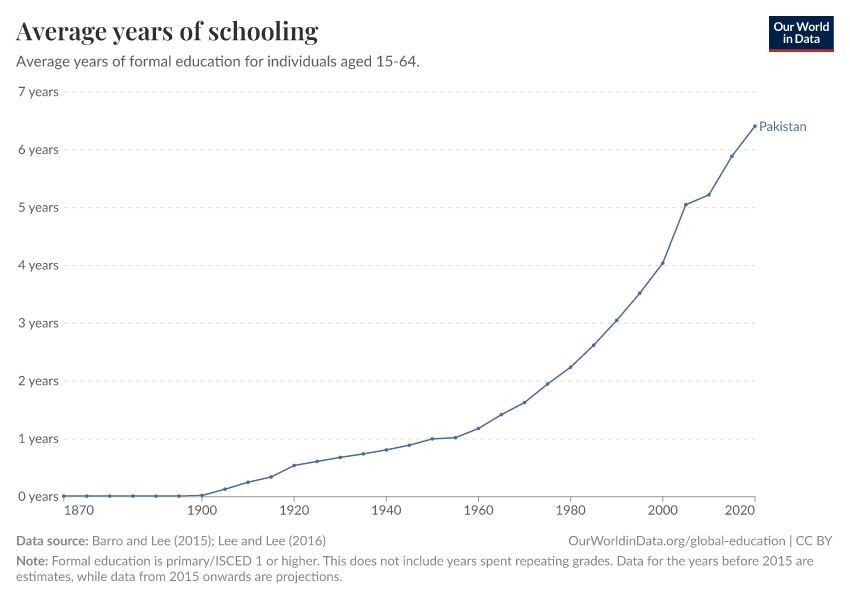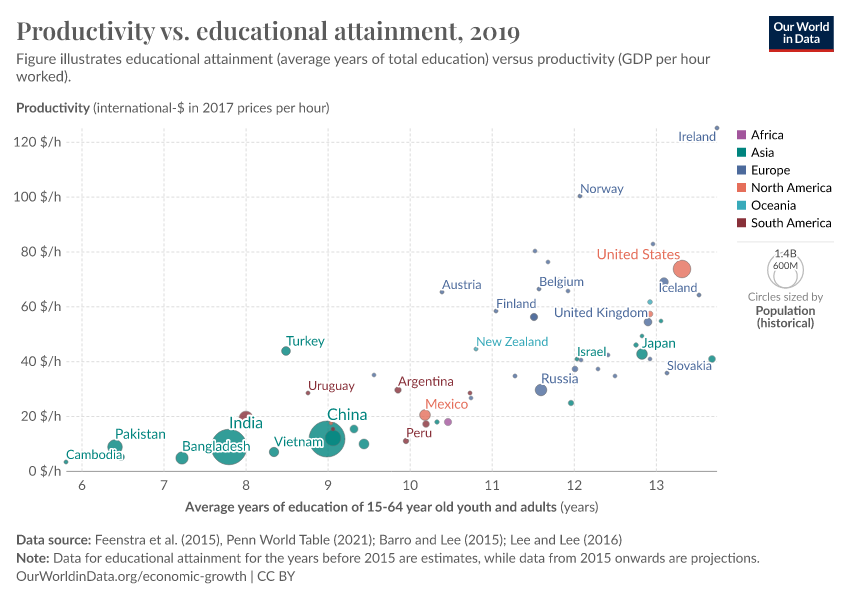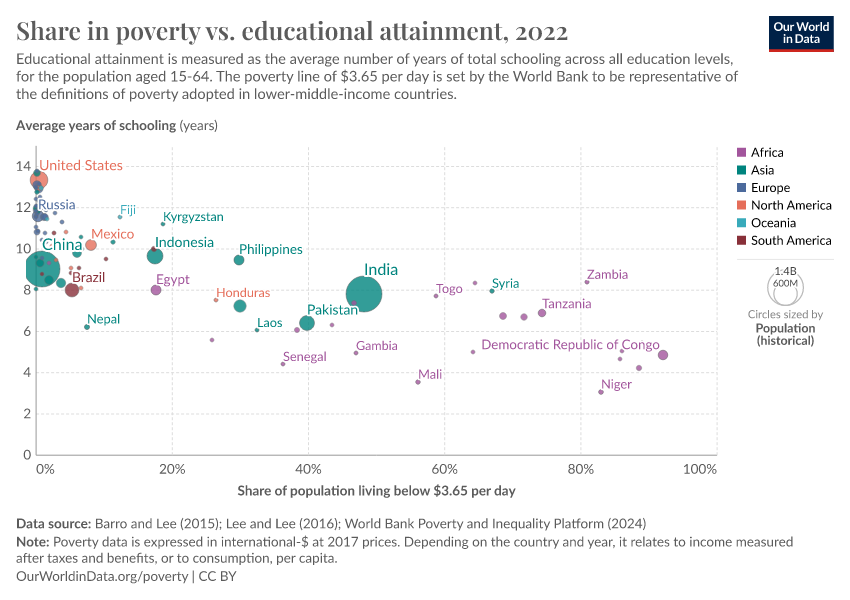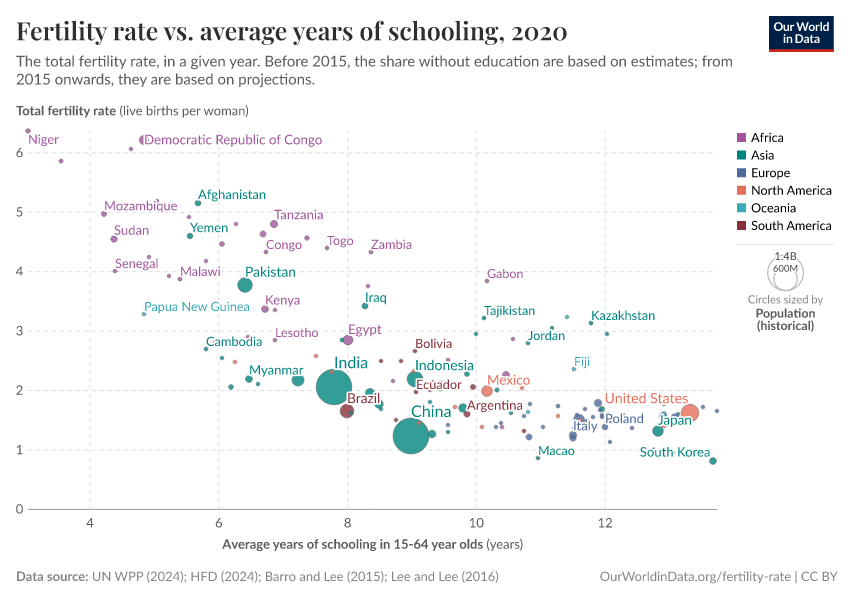Average years of schooling

What you should know about this indicator
- For the years leading up to 2015, the data are derived from historical estimates, providing a retrospective view of education levels. For the years 2015 and beyond, the projections are grounded in the historical data of 2010, which serve as the foundational benchmark. These forward-looking projections are then crafted by analyzing trends in school enrollment and changes in population structures. These trends are informed by forecasts from the United Nations, ensuring a global perspective and understanding of future educational developments.
- The method to estimate average years of schooling takes into account the age distribution in the population. This is important because access to education can vary significantly across generations. Older generations may have had fewer educational opportunities than younger ones, which affects the overall average education level.
- It also considers the typical duration required to complete each education level. For instance, primary education usually takes about 6 years, secondary education 4-6 years, and higher education may take even longer. Understanding the time investment required for different education levels is essential for accurate assessment.
- At its core, the method calculates the average years of schooling. This is achieved by determining the percentage of the population that has completed each education level and multiplying it by the duration of that level. The sum of these results gives a comprehensive view of both the extent of educational attainment and the time spent in education by the population.
- The method is dynamic, adapting to changes over time and across regions. For example, if a country increases the length of primary education, this change is included in subsequent calculations. This adaptability ensures that the average years of education remain relevant and accurate over time and across different educational systems.
- Note that the method does not take into account the quality of education. It only considers the number of years spent in education. This means that the average years of schooling may not reflect the actual skills and knowledge of the population.
Related research and writing
What you should know about this indicator
- For the years leading up to 2015, the data are derived from historical estimates, providing a retrospective view of education levels. For the years 2015 and beyond, the projections are grounded in the historical data of 2010, which serve as the foundational benchmark. These forward-looking projections are then crafted by analyzing trends in school enrollment and changes in population structures. These trends are informed by forecasts from the United Nations, ensuring a global perspective and understanding of future educational developments.
- The method to estimate average years of schooling takes into account the age distribution in the population. This is important because access to education can vary significantly across generations. Older generations may have had fewer educational opportunities than younger ones, which affects the overall average education level.
- It also considers the typical duration required to complete each education level. For instance, primary education usually takes about 6 years, secondary education 4-6 years, and higher education may take even longer. Understanding the time investment required for different education levels is essential for accurate assessment.
- At its core, the method calculates the average years of schooling. This is achieved by determining the percentage of the population that has completed each education level and multiplying it by the duration of that level. The sum of these results gives a comprehensive view of both the extent of educational attainment and the time spent in education by the population.
- The method is dynamic, adapting to changes over time and across regions. For example, if a country increases the length of primary education, this change is included in subsequent calculations. This adaptability ensures that the average years of education remain relevant and accurate over time and across different educational systems.
- Note that the method does not take into account the quality of education. It only considers the number of years spent in education. This means that the average years of schooling may not reflect the actual skills and knowledge of the population.
Sources and processing
This data is based on the following sources
How we process data at Our World in Data
All data and visualizations on Our World in Data rely on data sourced from one or several original data providers. Preparing this original data involves several processing steps. Depending on the data, this can include standardizing country names and world region definitions, converting units, calculating derived indicators such as per capita measures, as well as adding or adapting metadata such as the name or the description given to an indicator.
At the link below you can find a detailed description of the structure of our data pipeline, including links to all the code used to prepare data across Our World in Data.
Notes on our processing step for this indicator
Historical data up to the year 2010 has been sourced from 'Human Capital in the Long Run' by Lee and Lee (2016). This historical data was then combined with recent projections provided by Barro ane Lee (2015).
Regional aggregates were computed by Our World in Data through yearly population-weighted averages, where annual values are proportionally adjusted to emphasize the influence of larger populations.
Reuse this work
- All data produced by third-party providers and made available by Our World in Data are subject to the license terms from the original providers. Our work would not be possible without the data providers we rely on, so we ask you to always cite them appropriately (see below). This is crucial to allow data providers to continue doing their work, enhancing, maintaining and updating valuable data.
- All data, visualizations, and code produced by Our World in Data are completely open access under the Creative Commons BY license. You have the permission to use, distribute, and reproduce these in any medium, provided the source and authors are credited.
Citations
How to cite this page
To cite this page overall, including any descriptions, FAQs or explanations of the data authored by Our World in Data, please use the following citation:
“Data Page: Average years of schooling”, part of the following publication: Hannah Ritchie, Veronika Samborska, Natasha Ahuja, Esteban Ortiz-Ospina, and Max Roser (2023) - “Global Education”. Data adapted from Barro and Lee, Lee and Lee. Retrieved from https://archive.ourworldindata.org/20250909-093708/grapher/mean-years-of-schooling-long-run.html [online resource] (archived on September 9, 2025).How to cite this data
In-line citationIf you have limited space (e.g. in data visualizations), you can use this abbreviated in-line citation:
Barro and Lee (2015); Lee and Lee (2016) – with major processing by Our World in DataFull citation
Barro and Lee (2015); Lee and Lee (2016) – with major processing by Our World in Data. “Average years of schooling” [dataset]. Barro and Lee, “Projections of Educational Attainment”; Lee and Lee, “Human Capital in the Long Run” [original data]. Retrieved December 5, 2025 from https://archive.ourworldindata.org/20250909-093708/grapher/mean-years-of-schooling-long-run.html (archived on September 9, 2025).


